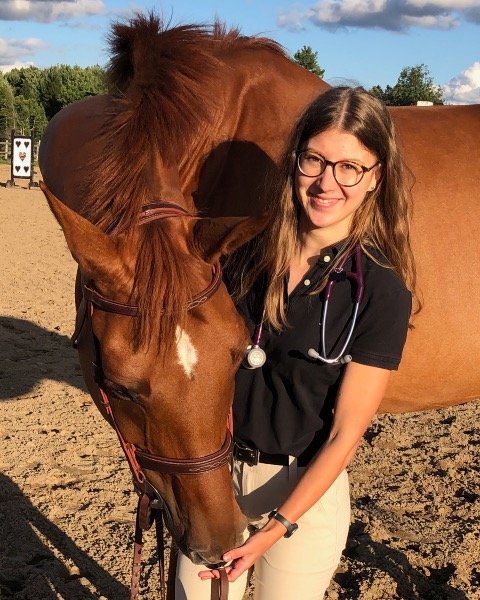Equine
In Person Only
E12 - Diagnosis of Bacteremia in Neonatal Foals Using High-Throughput Sequencing: A Pilot Study
Thursday, June 6, 2024
11:45am - 12:00pm CT
Location: MCC 200 E
CE: 0.25

Flavie Payette, DVM, MSc (she/her/hers)
Large Animal Internal Medicine Resident
New Bolton Center, University of Pennsylvania
Kennett Square, Pennsylvania, United States
Research Abstract - Oral Presenter(s)
Abstract:
Background – Neonatal septicemia is an important cause of morbidity and mortality in foals, requiring rapid identification and initiation of treatment for a favorable outcome. Diagnosis is however complicated by non-specific clinical signs and delayed confirmation of infection via blood culture. Molecular assays represent an attractive diagnostic complement by being rapid and more sensitive.
Objectives – To evaluate and compare bacterial load and composition in blood and blood culture media of sick and healthy foals, and to compare results with bacterial culture.
Animals – 13 septic hospitalized foals, 10 sick non-septic and 8 healthy foals.
Methods – Prospective pilot study. Bacterial load and composition from whole blood and from blood culture media pre-enriched for 5h and 24h were analyzed by quantitative PCR and sequencing of the universal bacterial 16S rRNA marker gene.
Results – Whole blood yielded more positive samples (25/31) than blood culture media (6/62; p< 0.0001), but 16S qPCR had low yield overall. Positive blood culture and whole blood sequencing were comparable in only 3/12 foals. The three most abundant genera on whole blood sequencing included Paucibacter (mean relative abundance 43.77%), Staphylococcus (10.21%), and Actinobacillus (7.12%). There were no statistically significant differences between the three groups of foals for alpha diversity, absolute DNA concentration, or sequencing read counts.
Conclusion and clinical relevance – High-throughput sequencing represents an interesting avenue for the diagnosis of bacteremia in foals but cannot replace blood culture at this time. Further research to optimize detection yield and sensitivity on whole blood samples is warranted.
Background – Neonatal septicemia is an important cause of morbidity and mortality in foals, requiring rapid identification and initiation of treatment for a favorable outcome. Diagnosis is however complicated by non-specific clinical signs and delayed confirmation of infection via blood culture. Molecular assays represent an attractive diagnostic complement by being rapid and more sensitive.
Objectives – To evaluate and compare bacterial load and composition in blood and blood culture media of sick and healthy foals, and to compare results with bacterial culture.
Animals – 13 septic hospitalized foals, 10 sick non-septic and 8 healthy foals.
Methods – Prospective pilot study. Bacterial load and composition from whole blood and from blood culture media pre-enriched for 5h and 24h were analyzed by quantitative PCR and sequencing of the universal bacterial 16S rRNA marker gene.
Results – Whole blood yielded more positive samples (25/31) than blood culture media (6/62; p< 0.0001), but 16S qPCR had low yield overall. Positive blood culture and whole blood sequencing were comparable in only 3/12 foals. The three most abundant genera on whole blood sequencing included Paucibacter (mean relative abundance 43.77%), Staphylococcus (10.21%), and Actinobacillus (7.12%). There were no statistically significant differences between the three groups of foals for alpha diversity, absolute DNA concentration, or sequencing read counts.
Conclusion and clinical relevance – High-throughput sequencing represents an interesting avenue for the diagnosis of bacteremia in foals but cannot replace blood culture at this time. Further research to optimize detection yield and sensitivity on whole blood samples is warranted.


